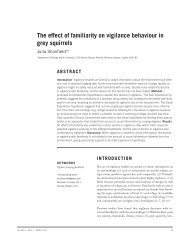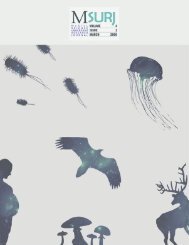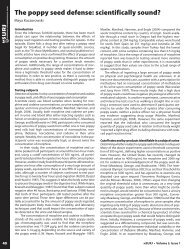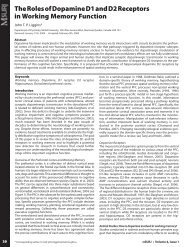the entire issue - McGill Science Undergraduate Research Journal ...
the entire issue - McGill Science Undergraduate Research Journal ...
the entire issue - McGill Science Undergraduate Research Journal ...
Create successful ePaper yourself
Turn your PDF publications into a flip-book with our unique Google optimized e-Paper software.
The effect of Eurosta solidaginis parasitism on pollinator preference in Solidago canadensis<br />
The fluctuations throughout <strong>the</strong> day likely result from differences in<br />
peak reward time (greatest nectar production) and preferred foraging<br />
time (hottest time of day) though data is not available to confirm<br />
this prediction. Our data demonstrates that <strong>the</strong> pollinators in<br />
this study were responsive to differences in flower quality, fur<strong>the</strong>r<br />
suggesting that galls do not affect flower attractiveness in a manner<br />
detectable by pollinators. Most importantly, this ability to make nonrandom<br />
foraging decisions serves to reinforce <strong>the</strong> notion that infection<br />
damage by E. solidaginsis at <strong>the</strong> genet level is negligible.<br />
There may be several reasons why infection damage was apparently<br />
negligible at <strong>the</strong> genet level. Hartnett and Bazzaz (1983) find that selective<br />
pressures may be mitigated at <strong>the</strong> patch (genet) level through<br />
<strong>the</strong> physiological integration of connected ramets (11). Fur<strong>the</strong>rmore,<br />
<strong>the</strong>y find that this may contribute to maintaining genetic diversity<br />
in <strong>the</strong> field by preventing genet death (11). Our study supports this<br />
notion by demonstrating how an environmental pressure such as a<br />
parasitic fly, which is draining to individual ramet, may be insignificant<br />
as a genet selection pressure.<br />
This study also provides some evidence in contrast to <strong>the</strong> prediction<br />
put forth by McCrea and Abrahamson (1985), that <strong>the</strong> genet may be<br />
negatively influenced by E. solidaginsis infection, should <strong>the</strong> level of<br />
infection be sufficiently severe (1). Our study found that even when<br />
infection was high (roughly 50% for many patches, reaching a maximum<br />
of 61.3% galled ramets), detriment to <strong>the</strong> genet was not sufficient<br />
enough to influence pollinators. Thus, even if a patch is quite<br />
infected, an important aspect of sexual reproduction (i.e. pollinator<br />
attraction) may remain unchanged. This indicates that <strong>the</strong> damage<br />
done by E. solidaginsis is not significant enough to select for resistance<br />
to infection.<br />
Additionally, <strong>the</strong> lower biomass allocated to <strong>the</strong> inflorescence in gall<br />
fly parasitized S. canadensis ramets (6) likely reduces <strong>the</strong> total volume<br />
of nectar available per inflorescence. Bumblebees are more sensitive<br />
to rewards based on sugar concentration, consistently choosing <strong>the</strong><br />
reward with a higher sugar concentration even when <strong>the</strong> overall reward<br />
is equal. Therefore, if <strong>the</strong> decrease in total biomass allocated<br />
to <strong>the</strong> inflorescence resulted in flowers with nectar concentrations<br />
equivalent to those found in uninfected ramets, <strong>the</strong>n it is possible<br />
that <strong>the</strong> presence of ball galls would have no effect on pollinator visitations<br />
at ei<strong>the</strong>r <strong>the</strong> patch or <strong>the</strong> ramet-level (5).<br />
With regards to pollinator preference within a patch, contrary to<br />
what was expected <strong>the</strong>re was no non-random pollinator preference<br />
pattern with respect to infected or uninfected ramets. This could<br />
mean that individual ramets within <strong>the</strong> patches were not damaged<br />
enough by <strong>the</strong> parasite to (a) influence pollinator preference, or (b)<br />
lose out on randomly foraging pollinators. Both of <strong>the</strong>se possibilities<br />
are supported by our data which demonstrates no significant difference<br />
between <strong>the</strong> proportion of open flowers on galled and ungalled<br />
ramets across patches. Additionally, while <strong>the</strong> literature puts forth<br />
evidence of many detrimental effects to galled ramets including reduced<br />
rhizome extension, seed production and biomass in general<br />
(1), it is possible that <strong>the</strong>se effects were ei<strong>the</strong>r not present in our<br />
sample size (supported by our comparison of open flower proportion)<br />
or simply not significant enough to influence pollinator behavior.<br />
Ano<strong>the</strong>r possibility is that once pollinators have made patch-level<br />
decisions, <strong>the</strong>y sample randomly within <strong>the</strong> patch.<br />
Conclusions<br />
The most significant findings of this study were that contrary to our<br />
prediction <strong>the</strong>re was no detectable pollinator preference at <strong>the</strong> level<br />
of <strong>the</strong> genet or <strong>the</strong> ramet. While this result is negative, it remains<br />
interesting because of <strong>the</strong> larger implications it has on <strong>the</strong> understanding<br />
of selective pressures to plants as <strong>the</strong>y can reproduce both<br />
sexually and asexually. For example, it is possible that in this case<br />
energy allocations between interconnected asexual ramets may<br />
provide a net benefit to <strong>the</strong> fitness of <strong>the</strong> genet (11) as it assists in<br />
keeping infected ramets healthy enough to not affect pollinator<br />
preference an important component of sexual reproduction in S. canadensis.<br />
Moreover, this study demonstrates how asexual reproduction<br />
in plants may contribute to stronger genet fitness by influencing<br />
sexual processes like pollination. The implications of this study call<br />
for fur<strong>the</strong>r research into <strong>the</strong> effectiveness of using pollinator preference<br />
as a measure of plant fitness as well as fur<strong>the</strong>r research towards<br />
understanding how selection pressures of varying severity act upon<br />
species, which can utilize both sexual and asexual reproduction.<br />
Acknowledgements<br />
We’d like to thank Felipe Perez, Simone Reader, Zophia Tanura,<br />
Andrew Hendry, Martin Lechowicz and Etienne Low-Decarie for all<br />
of <strong>the</strong> extra help and guidance.<br />
28<br />
<strong>McGill</strong> <strong>Science</strong> <strong>Undergraduate</strong> <strong>Research</strong> <strong>Journal</strong> - msurj.mcgill.ca









